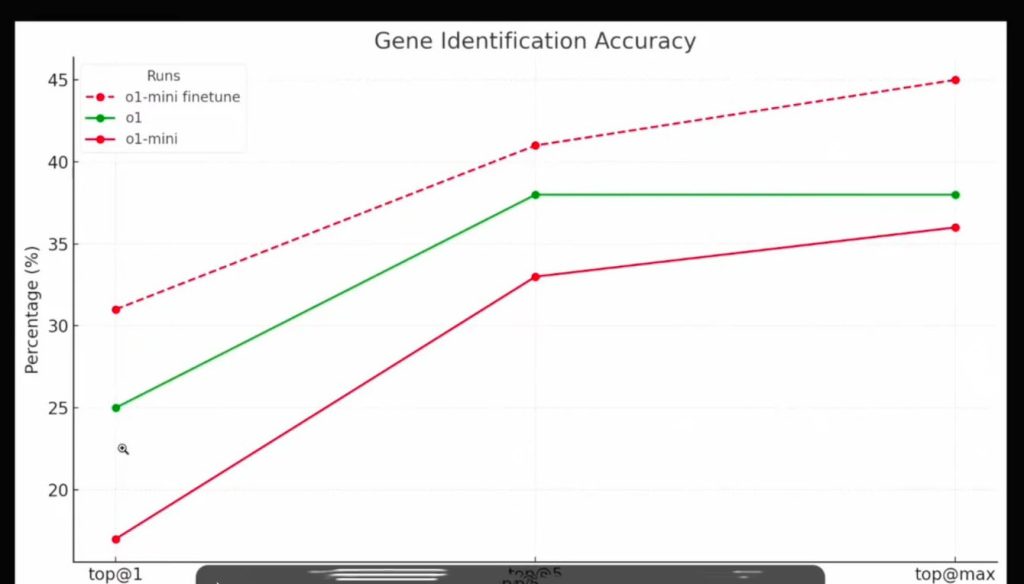
OpenAI 12-Day Conference – Day 2
Fine-Tuning O1 Models for Scientific Tasks:
On Day 2 of OpenAI’s 12-day conference, exciting updates were announced, focusing on the fine-tuning capabilities of the O1 model. Today’s session is especially important for researchers and tech developers, as it revealed how fine-tuning can significantly enhance the model’s accuracy and adaptability. Below are the key takeaways from the event:
1. Getting to Know the O1 Model: Intelligent Fine-Tuning for Complex Scientific Tasks
A standout feature of the O1 model is its ability to undergo fine-tuning after providing a standard answer, which enhances its performance in handling complex scientific research tasks. By learning from standard answers and optimizing itself, the O1 model becomes increasingly accurate in scientific research applications.
Notably, O1’s fine-tuning feature allows it to handle difficult tasks, such as gene discovery for genetic diseases. For example, it can identify and predict potential genes related to certain diseases. This has significant implications for fields like healthcare and life sciences.
2. Fine-Tuning Without the Hassle: OpenAI Handles the Process
Fine-tuning doesn’t require users to be experts in model training. OpenAI has created an easy-to-use platform where users simply need to provide the question and a small set of standard answers. The entire fine-tuning process is automated by OpenAI. This approach eliminates the need for complex configuration and allows researchers to focus on the content rather than the technicalities.
For researchers, this is a major advantage since they often lack the time and expertise to manage the intricacies of model training. OpenAI takes care of the fine-tuning process automatically, saving valuable time.
3. Company Feature Not Yet Live, But Coming Soon
Currently, the fine-tuning functionality is not fully available, but OpenAI has confirmed that it will be released early next year (within the next one to two months). If you’re highly interested, you can apply for early access to try the feature before it becomes publicly available.
Details of O1 Model Fine-Tuning:
1. Understanding Complex Scientific Tasks
One of the impressive aspects of the O1 model is its ability to understand complex scientific tasks. During the conference, OpenAI demonstrated how O1 can help solve genetic research problems. By analyzing the relationship between genes and genetic diseases, O1 was able to correctly identify a list of potential genes. Even more exciting, these results were verified and accepted by a genetics professor from the University of California, Berkeley, demonstrating O1’s real-world scientific application.
2. Fine-Tuning Significantly Improves Accuracy
Fine-tuning can lead to substantial improvements in model accuracy. In the demonstration, adding 1,100 standard samples increased O1’s accuracy by around 33%. Surprisingly, fine-tuned smaller models even outperformed the original larger models in accuracy. This discovery means that researchers can achieve better results with smaller, more efficient models that are tailored to specific tasks.

3. Simple and Efficient Fine-Tuning Process
The fine-tuning process is straightforward and user-friendly. All that’s required is to provide a set of standard answers. OpenAI has set up a specialized platform where users can upload their data, and the system automatically performs the fine-tuning. While the data doesn’t need to be extensive, it must differ from the test samples. The fine-tuning process typically takes anywhere from half a day to a full day, allowing users to see noticeable improvements quickly.
A Win-Win Situation: User Benefit and Model Optimization
Fine-tuning not only benefits the users but also helps OpenAI optimize its models. Through the data provided by users, OpenAI can refine the model’s performance in the most challenging scientific areas, accelerating the pace of iteration towards general AI. This is a win-win scenario where the users’ needs drive model improvements, and OpenAI’s technology helps users achieve breakthroughs in their research.
Conclusion:
Today’s conference showcased the tremendous potential of the O1 model’s fine-tuning capabilities, especially in scientific research. With automated fine-tuning, researchers can rapidly improve model accuracy and tackle complex scientific problems with ease, all without needing to manage technical details. Once the fine-tuning feature is officially launched, the O1 model will provide strong support for research across various fields, propelling scientific advancements.
If you’re interested in the fine-tuning capabilities of the O1 model, be sure to apply for early access and keep an eye out for future updates from OpenAI. This technology has the potential to bring significant benefits to researchers and developers in a wide range of disciplines.
- No Comments
- December 13, 2024
